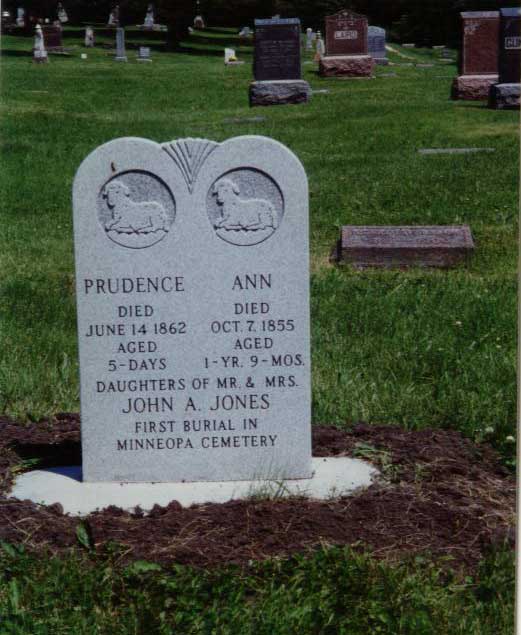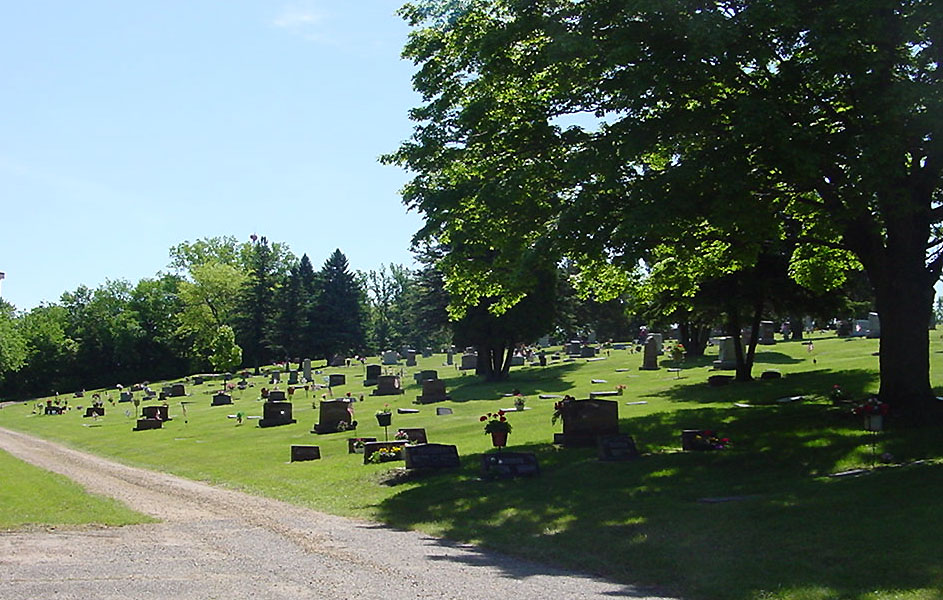History of Minneopa Cemetery
The oldest, still operating cemetery in Blue Earth County
The first burial at Minneopa Cemetery was for 2-year old Ann in 1855. She was the daughter of John A. Jones.

In 1855, in covered wagons, 11 Welsh families made the six week trek from Watertown, Wisconsin, and settled near Minneopa Falls (twice-falling water). They were stouthearted people who left their loved ones to face the pioneer life in untrodden wilderness which was in full possession of the Indians. Dense forests, swamps, swift running rivers, and non-existent wagon trails awaited them. They laid claims along the Minneopa Creek, erected their log churches and houses, and thus became the first permanent settlers of South Bend.
The original colony consisted of the following sturdy pioneers, who have long since passed into a better land and whose names grace the stones of Minneopa Cemetery. They were the families of Evan H. Evans, Hugh Edwards, Thomas Jones, William J. Roberts, Robert Williams, John Pugh Sr., Griffith Roberts, Thomas J. Jones, David Evans, David J. Lewis and John A. Jones.
The site of Minneopa Cemetery was first owned by D. C. Evans. He was a surveyor and owned all the land around Minneopa State Park. The first death in the colony was Ann Jones, infant daughter of Mr. and Mr. John A. Jones. Because the writing on the old marker was wearing away, in 1995, at Loren Crane's request, it was replaced with a new granite stone. It is the exact replica of the original except for the words "First burial". This is in Block 80. Other deaths occurred from time to time and brought about the necessity of a burial place. The beautiful heights above Minneopa Falls were chosen to be what was later nown as Minneopa Cemetery.
The cemetery started as a Welsh cemetery. Eventually the burial grounds were under the control of South Bend Township. According to Arthur Roberts, long time secretary, in 1868, when a railroad depot was to be built in South Bend, Mr. D.C. Evans gave a 700 square feet piece of the cemetery to the town. In 1902 the railroad was going through the area and wanted to straighten out an "S" curve. Hence the deep cut on the south boundary.
In 1908, due to heavy rains, there was a landslide from the railroad's cut into the hillside, which caused a few bodies to be washed down. The railroad made good the damage, and awarded the Town of South Bend $6,000. But, officials of the town used the money to build roads and bridges, and put only $200 of the $6,000 damage award back into the cemetery. The old settlers got stirred up and on Oct. 1, 1917 they took the cemetery away from the town and incorporated under the State of Minnesota.
The first financial record under the new corporation shows that the town board turned over $5,565.45 with $150 to be put into a Perpetual Care Fund. Eventually the State of Minnesota declared burial grounds as "holy ground" which means it cannot be condemned or infringed upon for any purpose. However, a cemetery can acquire ground by the process of eminent domain.
John W. Roberts was the first president of the new corporation and served for two years. G. A. Strom succeeded him and served for 27 years. Loren Crane was elected to take his place and served as president until 1963 when he became the treasurer. Loren served in that capacity until 1981. Daniel Williams was a first treasurer and filled that office until 1949. Arthur Roberts was elected secretary in 1917 and served until he died in 1981, a period of 64 years. We owe a huge debt of gratitude to these gentleman and others who guided and directed the cemetery so wisely for many years. It has to be said, however, that their services were founded on love and respect for their friends, the cemetery, and its significance in their lives.
In 1946 negotiations were started with the State of Minnesota to exchange 11.6 acres of land north of the cemetery (in section 16) for 8.6 acres west of the cemetery (in section 21) and across county highway #117. The west property was more suitable for burial grounds. This exchange was acted upon by the legislature. With the help of our state representative and our attorney, Charlotte Farrish, this was eventually accomplished. It took nearly nine years to prepare the "new" cemetery for burial. The first burial was in 1955, just 100 years after the first burial in the old cemetery. This was also a child, the daughter of Gerhardt and Bonnie Groth.
The financial history is interesting. The first complete and detailed financial report appeared in March of 1917. Assets were $5,565 --- $150 of that was the beginning of the Perpetual Care Fund. Property owners then had the option of paying an annual fee for cemetery upkeep, or they could pay perpetual care. Eventually annual fees became nearly impossible to collect; so, in 1941, perpetual care was made mandatory. Fifty per cent of the purchase price of property is put into the Perpetual Care Fund. Only the interest generated by that money can be spent; the principal is to be kept in perpetuity for maintenance of the cemetery. The State of Minnesota requires only 20% be set aside for permanent care. We have designated 50% to our perpetual care fund.
Our assets at this writing are about $280,000 ---- $110,000 of that is in the Perpetual Care Fund.
Ruth Roberts Otto - January 20, 2004
Sources of information:
Original By-laws
Minutes of Board Meetings
Newspaper articles
Financial Records
Statutes of Minnesota
